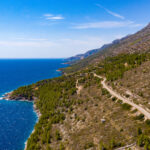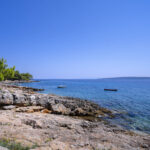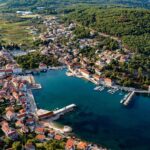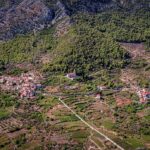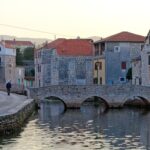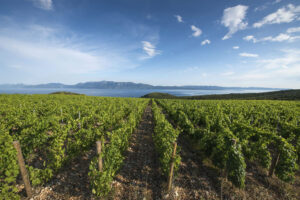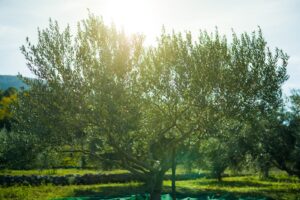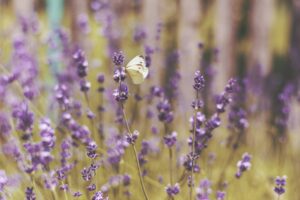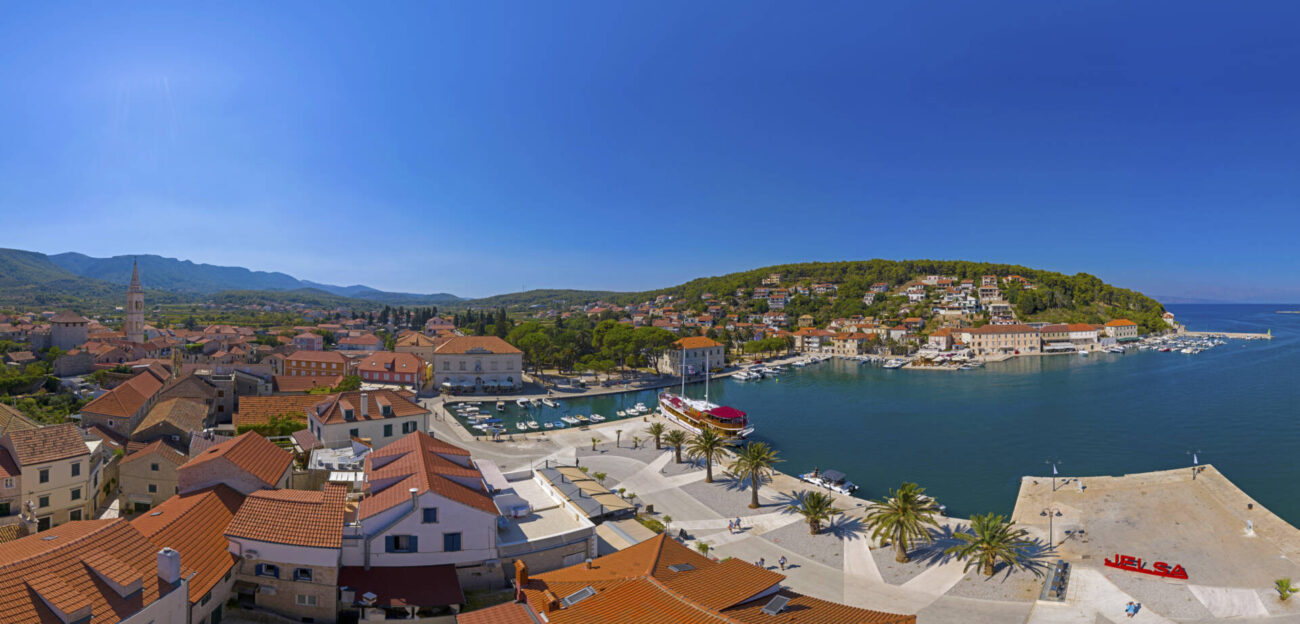
The Jelsa Region in 3 Days
Day 1
1. The Jelsa Park, with statues of Captain Niko Duboković Nadalini composer Antun Dobronić.
Created in 1870 on an alluvial plain, this park is one of the biggest and most beautiful in Dalmatia. In 1923 a statue by Ivan Rendić was erected in the park in honour of Captain Niko Duboković (1835 – 1912), who, as mayor for many years, was responsible for the modern development of Jelsa, including draining the swamps infested with malaria-carrying mosquitoes, and constructing the harbour waterfront.
The north part of the park was landscaped in 1950. The statue which is its centrepiece is of composer Antun Dobronić (1878-1955), and is the work of the Jelsan sculptor, academician Slavomir Drinković.
The purpose-built Town Hall was constructed on wooden stilt supports over marshy terrain, like the houses in Venice. The work started on May 15th 1894 and was completed on December 15th 1895. The facade of this Neo-Renaissance style building is 25 m in length. The stone for the outside cladding was sourced from the island of Vrnik near Korčula, while the internal walls used stone from Selca on Brač.
Half of the ground floor was occupied by a reading room and cafe. In the other half there was a ballroom with a coffered ceiling, walls painted in contrasting colours and five resplendent chandeliers.
3. The Piazza, The Square of Croatia’s National Revival – a place for gatherings and gossip.
The Piazza (Pjaca) was created by stages between the 16th and 19th centuries. On the west side of the square a fresh-water stream called the Slatina flows down a little channel to the sea. A drinking fountain was constructed in the middle of the square in 1934.
Nowadays the Piazza teems with cafes, restaurants, little shops and ice-cream parlours, where locals and tourists gather.
4. The Fortified Church Of Our Lady’s Assumption and the Lapidarium
The parish church is mentioned in the Hvar Statute of 1331 as ‘Sancta Maria di Ielsa, a single-nave early Gothic church. It is not known when the dedication was changed. In the 14th century it was enlarged with the addition of two aisles. Under threat from Turkish attack in 1535 the church was made into a fortress, and later fortified in 1573. At the end of the 19th century the church was totally renovated and a new belfry added. The church contains four chapels, two from the 17th century and two smaller ones from the 19th century.
In the courtyard space between the fortified church and its defensive wall there is a Lapidarium containing about 20 Antique and Medieval stone artefacts, which were placed there by the Hvar Cultural Centre in 1970. Among the exhibits is a grave headstone from Roman times, a 15th century relief by Niccolò Fiorentino (Nikola Firentinac), a Venetian lion, and a stone table which belonged to a knight called Ivan Obradić.
5. St. John’s Chapel, in its Renaissance-Baroque Square
The miniature octagonal chapel of St. John was first mentioned in historical documents in the 15th century. It was renovated and extended in Baroque style at the end of the 17th century.
The chapel was one of two centres which formed the nuclei for Jelsa’s future growth. Around it the settlement’s oldest houses are preserved intact, including some of those which belonged to Jelsa’s wealthy ship-owners and nobility. For instance, the family crest with the date 1561 is engraved in the lintel over the main door to the Skrivaneli family home. Houses were built and the little square adapted up to the end of the 19th century.
Tucked in its discreet little square among lofty patrician houses, St. John’s Chapel and Square is one of the finest architectonic complexes in Jelsa. In summer the square in front of the chapel comes to life as a beautiful open-air stage for a variety of cultural events, including concerts, plays, poetry readings and book promotions.
6. The Museum
Jelsa Council’s Museum is situated in a house which belonged to the Dobrović merchant family, whose members were notable participants in Jelsa’s cultural and intellectual life.. The house in its present form was extended at the end of the 19th century, and represents one of the best examples of Neoclassical residential architecture in Jelsa. It was gifted to Jelsa Council by the last family member to live in the house, Juraj Dobrović (b.1928), who is an internationally recognized artist.
There are two museum collections on display in the house. One consists of a collection of graphics, paintings and reliefs by Juraj Dobrović, which were gifted together with the house. The other, mainly on the first floor, is a cultural-historical collection displaying the authentic decorative and everyday objects contained in a typical patrician household from the second half of the 19th century and beginning of the 20th.
7. The Church of Our Lady of Health, and a Fine Belvedere
The church dedicated to Our Lady of Health is situated on the Račić hill overlooking Jelsa, and dates back to the 16th century. The original church was built on the site of a Medieval chapel in 1535, and was a votive church for mariners. Its current appearance overall dates from the 19th century, when the west aisle and belfry were added in 1863. The most recent major renovation works were completed in 2013, including landscaping the surrounding area and planting the slope leading up to the church with olive trees.
The church contains an altarpiece attributed to Palma the Younger (real name Iacopo Negretti, 1544 – 1628), two 18th century wooden sculptures and a beautiful 16th century icon in a Renaissance frame.
The church is only used on special occasions. One of these centres on the feast day for Our Lady of Health, which falls on November 21st. Mass is celebrated on consecutive days around that date, with a particular day allocated to each parish in the Jelsa region, so that parishioners make the pilgrimage from their home village to attend ‘their’ special mass.
The Račić hill offers a splendid view over Jelsa harbour and the Jelsan fields.
The watchtower called ‘Tor’ up in the hills above
Jelsa dates from the 4th century BCE. Constructed from megalithic
stone blocks, it is 7.4 m in length, 6.2 m wide and about 6 m high.
It was, of course, a vantage look-out point against enemy marauders
approaching the island.
9. Galešnik – A Late Antique Hillfort
Very little is known about the Late-Antique / Early Medieval town of Galešnik, which is not far from the Tor. It may have been a sanctuary for people fleeing from some destroyed settlement. Legend has it that the Slavogosta family, who were Hvar patricians, took refuge here after the failed rebellion against Venice in 1310, but there is no evidence to support this.
Day 2
Starting from Jelsa, across the fields up to the village of Pitve
PITVE
Pitve, with Dol, is the oldest settlement on the island, and is situated at the start of the Vratnik Gorge. The oldest part of the village, Gornje (Upper) Pitve arose along the ravine, and its natural defensive position ensured its survival from Illyrian times. The newer part, Donje (Lower) Pitve, was given the name Ostrvica by refugees from Bosnia in the 15th century. St. James’ Church was built on a rise between the two parts of the village in the 19th century. In the churchyard there is a stone head of Janus, the ancient two-faced god of entrances, although some experts believe this is a medieval artefact rather than a Roman original.
By the road between the two parts of the village is a harmoniously proportioned large stone building, which used to be the village school. For some time it was a museum, housing an exhibition of the island’s rich tradition of wine production with a lot of ethnographic items, and a second display honouring the men who died in the fight for freedom during the Second World War. Later the museum was closed, the building fell into disrepair, and then in 2012 a fire destroyed the roof and the whole interior. The Croatian Ministry of Culture temporarily declared the building a Material Cultural Asset, and helped with the finances for a complete renovation of the building. The intention is to establish a new museum there.
In former times, as in many other of the island’s villages, there was a distillery in Pitve for producing lavender oil.
VRISNIK
This village of old stone houses, drystone walls, picturesque courtyards and gardens, is 3 km from Jelsa. Its name derives from the Croatian word ‘vrijes’, meaning the plant ‘heather’. The houses range downhill from a peak which is topped by the parish church of St. Anthony the Abbot. The church is reached by a beautiful paved alleyway lined with cypresses. The church yard offers a magnificent view over the Stari Grad Plain, the nearby village of Selca, the carefully tended vineyards and olive groves, the Jelsa Bay and the sea looking over towards Brač Island and the Biokovo Mountain on the mainland.
Besides the main church, there are two little chapels, dedicated to St. Rocco and St. Dorothy. There is a large building in the village which belongs to the Agricultural Association. It was built in the 19th century on the basis of voluntary financial and practical contributions from the local people, and bears witness to the former importance of Vrisnik’s farming activities.
From Vrisnik to Svirče
SVIRČE
The village of Svirče nestles in a small corner beneath Hvar’s highest point, the St. Nicholas Peak (626 m) and alongside the UNESCO-listed Stari Grad Plain. Its architecture is typical of the island: the stone houses, little stone pathways and picturesque courtyards are redolent of past times and will take you on a journey of distant visions.
In one version, the name ‘Svirče’ is said to derive from the word ‘svirati’, meaning to play music, and legend has it that Svirče’s first settlers were shepherds who did indeed come there and played their music, and then settled for good. Another, less fanciful version has it that the name derives from ‘svir’ meaning ‘water source’, and that the settlement was founded in this place because it had water.
The style of the 18th century Church of St. Mary Magdalen is unique on the island: its central dome gives it a special charm. The graveyard alongside the church is impressively designed and tended.
From Svirče to Vrbanj
VRBANJ
The farming village of Vrbanj was once the most populated on the island. It does not actually belong in the Jelsa Council region, but we include it because effectively gravitates equally to Stari Grad, which is its administrative centre, and Jelsa, by dint of being part of the six-village Maundy Thursday Procession, ‘Za Križen’. It lies 5 km from Stari Grad, beside the Stari Grad Plain.
Vrbanj was the birthplace of Matij Ivanić, who led the People’s Uprising of 1510-1514. There are interesting remnants of a complex of Medieval buildings in the village, which the people named ‘Matij’s Court’ in Ivanić’s honour, and is otherwise called ‘The King’s Court’. It is thought that the complex was the seat of ducal rulers before the Commune was founded.
There is a genuine old-style wine-cellar (‘konoba’) near the Medieval complex, carefully preserved in the Bratanić family home, with authentic old equipment and items for wine-making. In July 2014 the Croatian Ministry of Culture declared the collection a Cultural Asset.
The area of Vrbanj was inhabited in prehistoric times: not far away between Vrbanj and Svirče there is a prehistoric archaeological fort called Gračišće, which has not yet been excavated. On the Hum hill near the village are the remains of prehistoric stone grave mounds, as well as the ruins of a pre-Romanesque chapel dedicated to St. Vitus. In Vrbanj itself there have been findings dating to Roman times.
The parish Church of the Holy Spirit was constructed in the 18th century on the site of an older church. The altarpiece by Baldassare d’Anna on the main altar depicts the Descent of the Holy Spirit on to the Apostles.
Above the village on St. Nicholas’ Peak, the highest point of the island at 626 m, is a little chapel dedicated to the saint, which was built in the 15th century by Matij Ivanić’s grandfather. In former times the village had a distillery (known locally as ‘lambik’), and ample quantities of lavender oil were produced, but which has now been converted into a modern winery and restaurant.
From Vrbanj to Vrboska
VRBOSKA
Inhabitants from Vrbanj and other places began to move down to the previously uninhabited narrow Vrboska bay in the 15th century in order to fish for sardines. With the advent of new technology, sardine fishing became one of the island’s most important economic activities. Records have been preserved of the construction of patricians’ and workers’ houses along the bay, including one on the waterfront for Matul Ivanić, grandfather of Matij, the leader of the People’s Uprising.
Vrboska’s history landmarks are the People’s Uprising of 1510-1514, the Turkish onslaught of 1571, internal battles, various epidemics, and changes of rulers. The village’s golden age came at the end of the 16th century to the first half of the 17th century, when the local residents restored their churches and embellished them with artworks by well-known Venetian masters.
St. Lawrence’s Church
The 15th century parish church of St. Lawrence holds the most important artistic fundus on the island. On the main altar is a painting of St. Lawrence with St. John the Baptist and St. Nicholas, with an array of vignette scenes, the work of Paolo Veronese. On the other ornate altars are works by Leandro Bassano, Antonio Scuria, Stefano Celesti, and Giuseppe Alabardi, as well as altar paintings by the well-known 20th century Croatian painters Celestin Medović and Marko Rašica.
The Fortified Church of St. Mary
Vrboska was in a position to order paintings from well-known artists because of the commercial success of the exports from its fishing industry. The fortified Church of St. Mary used to be adorned with some precious artworks, but some thirty years ago they had to be moved to St. Lawrence’s Church because of damp problems. For the same reason, a statue of St. Peter by Niccolò Fiorentino (Nikola Firentinac) was transferred to the parish church from St. Peter’s Chapel.
The Church of St. Mary, dedicated to Our Lady of Mercy, was built in the 14th century. It was badly damaged in the Turkish onslaught of 1571, after which it was fortified to gain its current appearance, with high towers and triangular bastions on the facade. The fortifications were built by the very best Venetian engineers, so that now, standing proud in the middle of its large square, it is an outstanding and beautiful example of fortified churches in Croatia.
The Fishing Museum
Vrboska is one of the best-known fishing centres on Hvar, and with its long-standing tradition of processing fish, it was a fitting place for the Fishing Museum. The Museum was founded in 1972 by the Centre for Protecting Hvar Island’s Cultural Heritage. it houses a beautifully presented display of the history of fishing on Hvar, with equipment, tools and photographs tracing the development of the island’s fishing industry. Almost all the different kinds of nets are on show here, hooks, spears, lamps for night fishing, fishermen’s outfits, processed fish, shells, sponges etc. Some of the equipment from the sardine factory is also on display, including a press for sealing the cans and the factory’s advertisements, as well as tools for the barrels and the pots and cutlery which were used in the island’s kitchens in former times. Of special interest is the reconstruction of a fisherman’s home.
The Sardine Factory in Vrboska
On the waterfront, a dominant feature is Vrboska’s Sardine Factory, now derelict, which was founded in 1894, and closed in 1972. At the beginning of the 20th century, when the Sardine Factory and boat-building yard were in full function, Vrboska was thriving, with regular ferry links to Split and Brač Island, a hotel and several fishing companies. It also benefited from a cultural centre, reading room and doctor’s clinic. Together with the nearby former boat-building yard for wooden boats, the factory’s impressive waterfront building was placed under protection by the Split Conservation Office of the Croatian Ministry of Culture, but this has not prevented it from falling into disrepair, a sad shadow of its former importance.
Day 3
From Jelsa to Pitve, and on to the south side
THE PITVE – ZAVALA TUNNEL
The only road link between the north and south sides of the island in the Jelsa Council region is the Pitve – Zavala tunnel, indeed, not so many years ago, until the purpose-built Selca-Dubovica road tunnel was opened in 1999, it was the only tunnel linking the two sides. Before the Pitve-Zavala tunnel was built, the only way to the south side was by a winding footpath or a more vertical donkey track leading up to the top of the hill and over the other side to the coast. Now there is a macadam fire road over the hill, which is used by vehicles which are too large to go through the tunnel.
The Pitve-Zavala tunnel is 1400m long and 2.30m wide. It was excavated in 1962 with the help of the army, and its original purpose was to hold giant water cisterns underground, which were part of a system of pipes transporting drinking water from Jelsa, which had its own springs, towards Hvar Town. When Hvar started to receive its water from the mainland, the cisterns in the tunnel were re-purposed to hold wines from the Plenković winery in Sveta Nedjelja. Since then, the tunnel has been used solely for traffic. Because it gave road access to the south coast, it stimulated the development of tourist rental apartments by the sea, at the foot of the old village of Zavala which lies up the hill.
The roof of the tunnel is low, and, like the walls consists of rough-hewn stone. The tunnel is one-way due to its narrowness, apart from a few passing places. Priority is given to traffic from the south side, when the traffic is free-flowing. In recent years a traffic light system has been introduced to make driving through the tunnel easier. The tunnel is, in its way, a tourist attraction, certainly an experience which visitors remember with a certain awe. It is safe for cars when drivers abide by the rules and take care, however bicycles, mopeds and motorbikes are not allowed inside.
From Gromin Dolac to Sveta Nedjelja
BEACHES on the south side of the island
Wherever you are based on Hvar Island, if you have the use of a car, you should not miss visiting the beaches on the island’s south side, where you can bathe in what is said to be ‘the most beautiful sea in the world’. In the Jelsa Council region it is the custom to refer to the villages on the south side which are linked to Jelsa administratively as ‘the Beaches’. These villages, Gromin Dolac, Zavala i Ivan Dolac, were built uphill away from the sea at the time when attacks from the sea posed a great threat to the inhabitants. Gradually, the settlements spread downwards towards the sea, so that in the last thirty-odd years new holiday villages have grown up along the coast.
From Jelsa you pass through the historic village of Pitve to reach the rough-hewn tunnel which leads to Zavala on the south side of Hvar Island. As you come out of the tunnel, one of Hvar’s exquisite vistas opens up in front of you. Ahead, you see the islet of Šćedro, with Korčula beyond it, and further in the distance the tiny island of Sušac. To the right lie the islands of Lukavci and Vis, with Biševo beyond Vis, while to the left is the Pelješac Peninsula. If you have the good luck to arrive after a strong storm has cleared the air of its summer haze, you might even see the Italian coast way over on the other side. All this beauty is bathed in the blue of the sea and the sky, and highlighted in the heat of the south side’s bright sunshine. Visitors often say that swimming from the island’s southern beaches is one of the most beautiful and unforgettable experiences ever.




